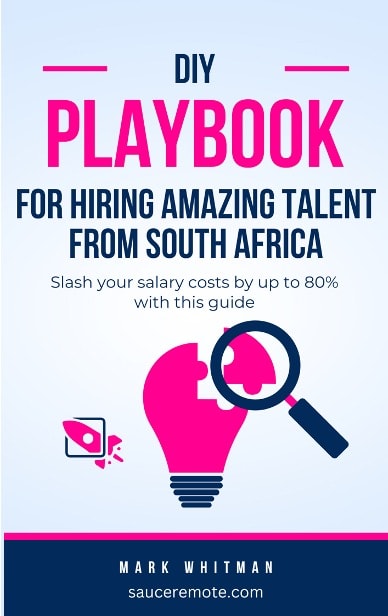Employee misclassification can sink your business.
Don’t believe me? Just look at Fedex and their $2.4 million lawsuit. Want more proof? Look no further than DynCorp International and their $7.7 million settlement.
What is employee misclassification? How does it happen, and can you do anything to prevent it?
Let me teach you everything you must know about employee misclassification.
Ready? Let’s roll.
What is Employee Misclassification?
Employee misclassification happens when a business incorrectly labels a worker as an independent contractor instead of an employee.
At first glance, it might not seem like a big deal. But, this seemingly small mistake can lead to significant legal and financial headaches.

Discover how to slash your salary costs by 80%
Get our exact process for hiring amazing overseas talent from South Africa. Includes copy-and-paste templates and a detailed salary guide.
What’s the Difference Between an Independent Contractor and an Employee?
An employee typically works under the company's control and direction—they follow set hours, use company equipment, and perform tasks dictated by their employer.
In contrast, an independent contractor generally has more freedom. They control how and when they work, often supply their own tools, and typically provide services to multiple clients, not just one.
Status Matters
Many employers think, “If I don’t want to offer benefits or pay taxes, I’ll just hire them as a contractor.” But it’s not that simple.
The IRS in the United States and the HMRC in the UK, among other regulatory bodies, have specific guidelines for determining a worker’s status.
For example, some employers assume that if a worker signs an independent contractor agreement, they’re in the clear. Not true.
Even if both parties agree to the contractor label, if the worker’s job duties and relationship with the company align more closely with those of an employee, they’re legally considered an employee.
Examples of Employee Misclassification
Imagine a tech company hiring a developer to work on a project.
The company dictates the developer’s work hours, provides all the necessary tools, and expects the developer to work solely for them during the project’s duration.
Although they call the developer a contractor, the reality of the situation makes them an employee in the eyes of the law.
Here’s another scenario.
A delivery service classifies all its drivers as independent contractors to avoid paying benefits and overtime.
However, the company controls the drivers’ routes, schedules, and even how they interact with customers. This level of control means the drivers are likely employees, not contractors, despite what their contracts might say.
Hire remote talent from South Africa & slash salary costs by 80%
Salaries start from £8,000 per year!
3 Dangers of Employee Misclassification
Employee misclassification is a ticking time bomb that can lead to serious consequences for your business. Here’s a closer look at how employee misclassification can hurt your business.
1. Legal Risks
When you misclassify an employee as an independent contractor, you’re not just bending the rules—you’re breaking them.
Regulatory bodies like the IRS and the Department of Labour take misclassification seriously.
Your business could face hefty fines and penalties if they catch wind of it.
Even worse, you could be dragged into lawsuits by misclassified workers seeking compensation for unpaid wages, benefits, and more.
These legal battles are expensive and can tarnish your company’s reputation.
But there’s even more danger in misclassifying an employee.
2. Financial Consequences
Think of misclassification as a financial black hole.
If your business is found guilty of misclassifying workers, you could be on the hook for back taxes, including Social Security and Medicare or NI contributions that should have been paid for employees.
Additionally, you might owe back pay for overtime, minimum wage discrepancies, and benefits like health insurance or retirement contributions.
These unexpected costs can quickly add up, straining your budget and potentially putting your business’s financial health at risk.
3. Operational Disruptions
Beyond the legal and financial fallout, employee misclassification can cause significant operational disruptions.
Misclassified workers might feel undervalued or exploited, leading to low morale and decreased productivity.
If the issue becomes public, it can damage your brand’s reputation, making it harder to attract top talent or retain existing employees.
Besides, dealing with the aftermath of misclassification—like audits, lawsuits, or reclassifying workers—can divert time and resources away from your core business activities.
Hire remote talent from South Africa & slash salary costs by 80%
Salaries start from £8,000 per year!
When Misclassification Goes Wrong
While the dangers of employee misclassification are clear on paper, do companies that misclassify their employees actually get into trouble?
They sure do. Let’s look at a few real-world examples to see just how serious employee misclassification can be.
FedEx Ground:
In one of the most high-profile cases, FedEx was sued multiple times by drivers classified as independent contractors.
The courts eventually ruled that these drivers were, in fact, employees, leading to a settlement that cost FedEx $2.4 million.
The case highlighted how even large, well-known companies could stumble over employee classification issues.
Uber and Lyft:
These rideshare giants have faced ongoing legal battles over whether their drivers should be classified as employees or contractors.
In California, Assembly Bill 5 (AB5) aimed to reclassify many gig workers as employees, sparking significant controversy and legal action.
The debate has led to millions in legal fees and a constant tug-of-war with regulators.
DynCorp International:
This American defence contractor faced a $7.7 million settlement after the U.S. Department of Labor found that it had misclassified hundreds of workers, denying them proper overtime pay.
The case served as a stark reminder that misclassification isn’t just a problem for tech companies or gig platforms—it can happen in any industry.
Hire remote talent from South Africa & slash salary costs by 80%
Salaries start from £8,000 per year!
How to Avoid Employee Misclassification
Avoiding employee misclassification might seem daunting, but it’s absolutely doable with the right approach. Here’s how you can protect your business from this common pitfall.
1. Understand the Classification Criteria
The first step in avoiding misclassification is understanding the key factors distinguishing an employee from an independent contractor.
These factors generally revolve around three main areas:
- Control: This is the big one. The worker is likely an employee if your business controls how, when, and where the work gets done. On the other hand, independent contractors have the freedom to decide how to achieve the results they’re hired for.
- Financial Investment: If the worker has significantly invested in their tools, equipment, or workspace, they’re more likely to be an independent contractor. Employees typically use the company’s resources.
- Relationship Nature: Look at the relationship’s longevity and exclusivity. Employees usually have ongoing, indefinite relationships with their employers, while independent contractors are more likely to work on a project-by-project basis and for multiple clients.
Understanding these criteria is crucial because misclassification often stems from misunderstanding what makes someone an independent contractor versus an employee.
2. Implement a Compliance Checklist
Create and use a compliance checklist to ensure you’re classifying workers correctly. Here’s a simple but effective one that I often use:
- Control: Do you control how and when the worker does their job?
- Integration: Is the worker’s role integral to your business?
- Independence: Does the worker operate independently, with their own tools and methods?
- Contract Length: Is the work relationship ongoing or project-based?
- Exclusivity: Does the worker serve other clients, or do they work exclusively for you?
Regularly review this checklist for each worker, especially when their roles or responsibilities change.
3. Perform Regular Reviews and Audits
Misclassification risks can creep up over time, especially as roles evolve.
Conduct regular internal audits to review your worker classifications. This process should involve HR, legal, and finance teams to consider all aspects of the worker’s relationship with your company.
Periodic reviews can catch misclassification issues before they turn into bigger problems.
4. Educate and Train Managers
Your managers are on the front lines of hiring and managing workers, so it’s crucial they understand the ins and outs of worker classification.
Regular training sessions help managers stay informed about the latest regulations and best practices.
This proactive approach reduces the risk of misclassification by ensuring that those making classification decisions are well-educated on the subject.
And now, my favourite way to avoid employee misclassification.
5. Use an EOR
Navigating worker classification can be tricky, but you don’t have to go it alone.
An Employer of Record (EOR) service can save you time and money. For instance, Sauce’s EOR service can remove the guesswork from worker classification.
We handle all the compliance details, ensuring your workers are classified correctly and in line with local labour laws.
The result?
By partnering with Sauce, you can focus on growing your business without the worry of potential employee misclassification risks hanging over your head.
